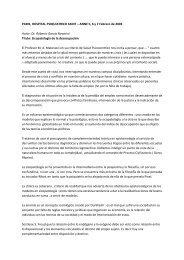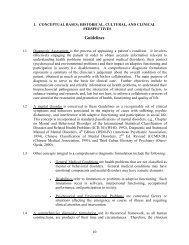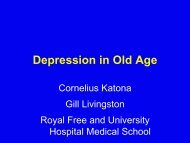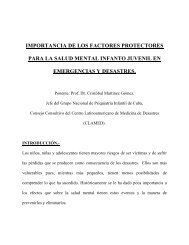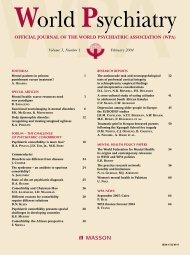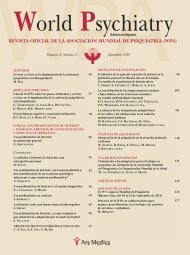ABSTRACTS - World Psychiatric Association
ABSTRACTS - World Psychiatric Association
ABSTRACTS - World Psychiatric Association
Create successful ePaper yourself
Turn your PDF publications into a flip-book with our unique Google optimized e-Paper software.
PO3.133.<br />
PATTERNS OF CARE IN PATIENTS DISCHARGED<br />
FROM ACUTE PSYCHIATRIC INPATIENT FACILITIES:<br />
A NATIONAL SURVEY IN ITALY<br />
A. Preti, P. Rucci, A. Gigantesco, G. Santone, A. Picardi,<br />
R. Miglio, G. de Girolamo, for the PROGRES-Acute group<br />
Department of Psychology, University of Cagliari, Italy;<br />
Department of Psychiatry, School of Medicine, University<br />
of Pittsburgh, PA, USA; Mental Health Unit, Center<br />
of Epidemiology, Health Surveillance and Promotion, Italian<br />
National Institute of Health, Rome, Italy; <strong>Psychiatric</strong> Clinic,<br />
United Hospitals of Ancona and Polytechnic University<br />
of Marche, Ancona, Italy; Faculty of Statistics, University<br />
of Bologna, Italy; Health Care Research Agency, Emilia-Romagna<br />
Region, Bologna, Italy<br />
The present study focuses on the characteristics of patients scheduled<br />
for discharge enrolled in the framework of a nationwide survey of<br />
acute psychiatric inpatient facilities in Italy, and their pattern of care,<br />
i.e., two topics that have rarely received comprehensive attention.<br />
Socio-demographic and clinical characteristics, and pattern of care of<br />
1,330 patients discharged from public (n=130) and private (n=36)<br />
inpatient facilities in Italy were assessed during an index period in the<br />
year 2004. The most common diagnoses were schizophrenia and<br />
bipolar disorder. Polypharmacy (prescription of two or more drugs of<br />
different classes) was the sample’s most frequent form of treatment,<br />
involving more than 90% of patients; approximately 25% of these<br />
patients received more than one antipsychotic drug. Treatment with a<br />
combination of different antidepressants was less frequent (ranging<br />
from 6% to 15%, according to the facility type). Patients of male gender,<br />
single, and unemployed were more likely to be discharged to<br />
community residential facilities or to other inpatient facilities than to<br />
their homes. Families were significantly involved in decisions about<br />
patients’ discharge and this emphasizes their role for patients’ support<br />
after the hospital stay, as well as the burden of informal care of<br />
severe psychiatric patients. This study provides important information<br />
for improving the care of patients admitted to public and private<br />
inpatient facilities in a country that has closed down all its mental<br />
hospitals, providing all psychiatric care by a network of communitybased<br />
mental health services.<br />
PO3.134.<br />
TRIAGE: A NEW MODEL FOR ACUTE INPATIENT<br />
PSYCHIATRY<br />
M. Lanzaro<br />
Department of Psychiatry, Camden and Islington Foundation<br />
NHS Trust, London, UK<br />
The aim of this paper is to describe a new model of psychiatric care<br />
which has been used for 18 months across an adult psychiatric service<br />
in North London. The Grove Centre opened in August 2005 and<br />
is a purpose-built inpatient unit. We have 44 inpatient beds on three<br />
wards: Fleet, Solent and Isis. Isis is a 12 assessment unit and the local<br />
consultants provide input to assist with initial triage/assessment (up<br />
to 21 days). Fleet and Solent are intermediate (second triage step)<br />
wards and both have 16 beds, with one whole-time equivalent consultant<br />
and two trainees. The introduction of the new model has<br />
apparently resulted in a more efficient use of beds, with encouraging<br />
preliminary results in terms of bed occupancy and other performance<br />
indicators, with good feedback from patients and staff. The model<br />
supports the evolving relationship between inpatient and community<br />
services through a whole system approach, and aims to better meet<br />
patient needs and minimise the length of stay by providing meaningful<br />
integrated therapeutic interventions. An audit has been planned to<br />
determine whether benefits persist or disadvantages emerge. The role<br />
of the dedicated consultant(s) is discussed, in the light of the changing<br />
roles for mental health staff auspicated by the principles of “new<br />
ways of working” in the UK.<br />
PO3.135.<br />
FIRST RESULTS ON THE MENTAL<br />
HEALTH OF THE POPULATION LIVING<br />
IN THE EPIDEMIOLOGIC CATCHMENT<br />
AREA IN MONTREAL, CANADA<br />
J. Caron, D. Pedersen, M. Perreault, M-J. Fleury, A. Crocker,<br />
A. Brunet, J. Tremblay, S. Beaulieu, G. Turecky, V. Nair,<br />
M. Daniel, M. Cargo, Y. Kestin , M. Tousignant<br />
Douglas Mental Health University Institute, McGill University,<br />
Montreal, Quebec, Canada; School of Health Sciences, University<br />
of South Australia, Adelaide, Australia; University of Montréal,<br />
Quebec, Canada<br />
We received a grant from the Canadian Institute of Health Research to<br />
develop the first Epidemiological Catchment Area Study in Canada.<br />
Five neighbourhoods in the south-west of Montreal regrouping<br />
258,000 persons will be studied. The objectives of that research program<br />
are: a) to examine the links and interactions between individual<br />
determinants, neighbourhoods’ ecology (physical and socioeconomic<br />
environment) and mental health in each areas of the predetermined<br />
region; b) to identify the conditions facilitating the integration of individuals<br />
with mental health problems in each community and the obstacles<br />
to that integration, such as social stigma and antisocial behaviour;<br />
c) to understand the impact that social, economical and physical<br />
aspects of neighbourhoods’ ecological context have on mental health<br />
using a geographic information system; d) to verify the adequacy of<br />
mental health services in relation with the needs of the population. The<br />
methods include a longitudinal epidemiological study under the form<br />
of a community survey, followed by qualitative studies of particular<br />
issues (i.e., services organization, social stigma and social support<br />
actualization). The longitudinal study, using standardized instruments,<br />
includes a randomly selected sample of 2,400 individuals aged from 15<br />
to 65 years, who will be interviewed at a two-year interval. We present<br />
the results of the first wave of the research program, including the incidence<br />
and prevalence of psychological distress, mental disorders, substance<br />
abuse, parasuicide and risky behaviour; quality of life; risk and<br />
protective factors in mental health and the effects of poverty.<br />
PO3.136.<br />
GENERAL PRACTICE AND MENTAL HEALTH CARE:<br />
DETERMINANTS OF OUTPATIENT SERVICE USE<br />
H.-M. Vasiliadis, R. Tempier, A. Lesage, N. Kates<br />
Department of Community Health Sciences, University<br />
of Sherbrooke, Quebec; Department of Psychiatry, University<br />
of Saskatchewan, Saskatchewan; Department of Psychiatry,<br />
University of Montréal, Quebec; Department of Psychiatry<br />
and Behavioural Neurosciences, McMaster University,<br />
Ontario, Canada<br />
This study aimed to examine the determinants that lead Canadian<br />
adults to consult family physicians (FPs), psychiatrists, psychologists,<br />
psychotherapists and other health professionals for mental health reasons<br />
and compare the determinants of service use across provider<br />
types. Data from the CCHS1.2 was used for persons aged 18 years and<br />
older (n=35,236). A multivariate logistic regression was used to model<br />
284 <strong>World</strong> Psychiatry 8:S1 - February 2009




